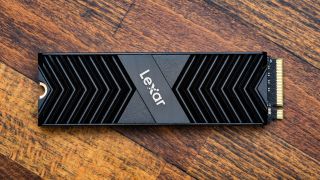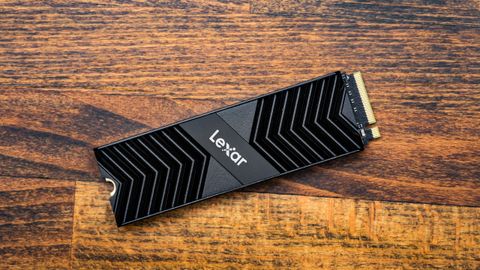Tom's Hardware Verdict
The Lexar Professional NM800 Pro is a high-end PCIe 4.0 NVMe SSD that at this stage can’t quite keep up with some of the better drives in its class. It’s priced right at 2TB and runs cool and efficiently thanks to its heatsink and design. This makes it a fair all-around choice.
Pros
- +
Competitively priced at 2TB when on sale
- +
Power efficient
- +
Stays very cool, especially with its heatsink
- +
Relatively high TBW
Cons
- -
Some performance inconsistencies
- -
Better drives to be had at lower capacities
Why you can trust Tom's Hardware
The Lexar Professional NM800 Pro is a high-end PCIe 4.0 NVMe SSDs that enters a crowded market but can set itself apart with its high efficiency and low temperatures. This drive is best caught on sale and particularly at 2TB, where it would be great for the PlayStation 5 or a gaming desktop. It sets no new performance records and has some inconsistent performance results, which keep it off the best PS5 SSDs and best SSDs overall lists, but on the whole it performs well enough to get the job done. With PCIe 5.0 SSDs on the horizon, this drive may best be suited to adding extra fast storage to your system.
SSD prices have been dropping fast for a while now so it’s important to score the right deal. This drive should be included in your list if the above characteristics fit your criteria. Another drive in this class that’s been priced low in recent sales is the Crucial P5 Plus, but the NM800 Pro is the superior choice as it generally performs better and comes with a stylish heatsink. The non-heatsinked version should be okay in a laptop if you really want full PCIe 4.0 bandwidth.
On the other hand, there are many drives faster than the NM800 Pro, even if the performance gap can be difficult to subjectively feel in the day-to-day. Our recommendation is to put this drive in your PS5 or as a secondary PC drive when it’s priced right, particularly at 2TB. The NM800 Pro does not really stand out in any other way.
| Product | 512GB | 1TB | 2TB |
|---|---|---|---|
| Pricing | $69.99 | $83.49 | $129.99 |
| Form Factor | M.2 2280 | M.2 2280 | M.2 2280 |
| Interface / Protocol | PCIe 4.0 x4 | PCIe 4.0 x4 | PCIe 4.0 x4 |
| Controller | IG5236 | IG5236 | IG5236 |
| DRAM | LPDDR4X | LPDDR4X | LPDDR4X |
| Flash Memory | 176-Layer Micron TLC | 176-Layer Micron TLC | 176-Layer Micron TLC |
| Sequential Read | 7,450 MBps | 7,500 MBps | 7,500 MBps |
| Sequential Write | 3,500 MBps | 6,300 MBps | 6,500 MBps |
| Random Read | 500K | 1000K | 1300K |
| Random Write | 900K | 1100K | 1200K |
| Security | N/A | N/A | N/A |
| Endurance (TBW) | 500TB | 1,000TB | 2,000TB |
| Part Number | LNM800P512G-RNNNG | LNM800P001T-RNNNG | LNM800P002T-RNNNG |
| Warranty | 5-Year | 5-Year | 5-Year |
The Lexar Professional NM800 Pro is available in 512GB, 1TB, and 2TB. The prices at the time of review are $69.99, $83.49, and $129.99, respectively. This pricing is competitive at 1TB and especially 2TB, but the market has been volatile. This is a drive that you might have to catch on sale, regardless of capacity.
The NM800 Pro can push PCIe 4.0 bandwidth at up to 7500/6500 MBps and 1300K/1200K IOPS for sequential/random reads and writes, respectively. Lexar warranties this drive for five years and 1PB of writes per TB capacity. This endurance rating is more than the industry average, although that is generally not a significant factor.
Software and Accessories for Lexar Professional NM800 Pro

Lexar does not offer any special downloads or accessories for this drive, beyond the optional heatsink variant. We recommend Clonezilla or similar for imaging/cloning and CrystalDiskInfo for general health analysis.
A Closer Look at Lexar Professional NM800 Pro





Our sample arrived with a heatsink, which is a nice addition. Some competing drives lack a heatsink which is beginning to be an issue with high-end drives that can experience thermal throttling without one. Lexar also sells a version of this drive without a heatsink. Either one would work fine for PlayStation 5 use. Underneath the heatsink, the drive is essentially identical to the non-heatsinked version.
Beneath the label, we spot a controller, a DRAM package, and two NAND packages. Even at 2TB this drive manages to be single-sided which is particularly challenging at this capacity. This makes it an option for certain tricky builds, including some laptops and HTPCs.


The controller is the InnoGrit IG5236, a popular 8-channel design that’s used for high-end PCIe 4.0 drives. Usually these drives are cheaper than competing SSDs built around Phison’s E18 or proprietary solutions. In the future it will have to tackle faster, 4-channel controllers that can max out the interface, such as the Maxio MAP1602 found on the Acer Predator GM7. Some other examples include the TenaFe TC2201 and SMI SM2268XT. These controllers are DRAM-less with fewer, faster channels, which makes them particularly competitive on price and for application in laptops.
The DRAM is labeled FLXC2002G-N2, which is LPDDR4X. This is extremely efficient DRAM, which should allow the NM800 Pro to run more efficiently as a whole, although DRAM is just one component. This will also help a little with thermal management, with or without a heatsink. This is 2GB of DRAM, which is an excellent amount for 2TB of flash.

The NM800 Pro uses Micron’s 176-Layer TLC, or B47R. This flash is typically sold with 64GB dies which implies each 1TB NAND package contains 16 dies in a HDP or 16DP configuration. This is usually the most amount of dies one can reasonably stack per package.
Lexar has the option of swapping to other flash, such as the efficient YMTC TLC found on the Predator GM7, but reports are that the IG5236 SSD controller has firmware issues with YMTC flash. The efficiency of that flash would be a nice fit on this drive and it seems other flash manufacturers have taken notice of the possible advantages found with such a design.
MORE: Best SSDs
MORE: Best External SSDs and Hard Drives
MORE: How We Test HDDs And SSDs
MORE: All SSD Content

Shane Downing is a Freelance Reviewer for Tom’s Hardware US, covering consumer storage hardware.

TSMC's labor practices draw serious concern in Arizona — the company's new chip plant allegedly struck by worker abuses

Former EKWB Employees say company has racist, hostile work environment, withholds overtime pay

Gigabyte confirms Ryzen 9000 branding for Zen 5 processors, preps beta BIOS updates for 500-series motherboards
